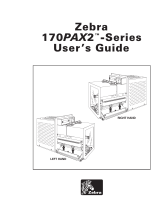
5
Explanation of the Circuit Diagram
Optocouplers are used to isolate the printer from the inputs. This
protects the printer from any potential damage in case of a wiring error.
X1 / X2 - input signal Start printing
Print on Demand
X1 / X2 must be used in the Print on Demand mode.
The signal Start printing is sent to the printer when 24V is applied to X1
and ground is applied to X2.
The current is limited internally by a current limiting resistor of 2.2 kW at
10mA.
When turning on the printer, this signal should not be present.
Print after Label Taken
The X1 / X2 signal is not used in the Print after Label Taken mode.
X1 and X2 must remain unconnected.
A jumper must be added between JP1-6 and JP1-2 to configure the
Print after label taken mode.
X3 / X4 - output signal Printer error
If an error occurs, (e.g. out of paper or ribbon), the output is revers
biased, which means that the optocouplers transistor output appears as
an open circuit.
The current must be limited externally to 10mA.
The voltage at the outputs should not be higher than 30V.
X5 / X6 - output signal Label is ready
If this signal occurs, the output is reverse biased, which means that the
optocouplers transistor output appears as an open circuit.
The current must be limited externally to 10mA.
The voltage at the outputs should not be higher than 30V.
X7 / X8 - input signal Label is taken
The signal Label is taken is sent to the printer when 24V is applied to
X7 and ground is applied to X8.
The current is limited internally by a current limiting resistor of 2.2 kW.
X9 / X10 - 24P
The 24V available at X9 (+) may only be used for supplying voltage to
passive switches (e.g. foot switches, hand-buttons).
The 24V may also be used as power supply for a sensor only if X10
(ground) is used as its ground.
Caution !
When using a powered sensor or other external device, always be
sure to connect the adapters ground at X10 to the ground of the
external device to prevent the possibility of a floating ground, which
could cause erroneous signals on the adapter.
The current is limited to a maximum of 100 mA.
Using higher current will damage the device !








